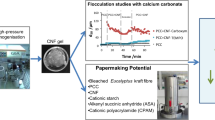Abstract
This work was aimed to color cellulose electrospun nanofibrous mats (ENMs) with synthetic indigo dyes through the process of pad dyeing. The industrial-scale dyeing procedure, which involved pre-wetting the mats, dyeing them and finally washing them off, was adopted for the study. Dyeing parameters of dyebath pH and temperature, and concentrations of sodium hydrosulphite and indigo dyes were optimized for the color yield (K/S) of the dyed mats. The dyed cellulose ENMs produced excellent K/S values up to 13 with good colorfastness properties. The cellulose ENM was also dyed with aniline-free synthetic indigo dyes for comparing the results with the conventional synthetic indigo dye. The dyeing effluents were tested for pH, TDS (Total Dissolved Solids) and COD (Chemical Oxygen Demand) contents. The dyeing effluent of aniline-free synthetic indigo dyes had considerably reduced values in comparison to the synthetic indigo dyes, i.e. 27% reduction in the TDS contents and around 16% reduction in the COD contents. Furthermore, the ATR-FTIR spectroscopic analysis confirmed successful conversion of the cellulose acetate to the cellulose polymer and the SEM analysis revealed that the morphology of the undyed and the dyed ENMs was similar. This is a scientific progress towards coloration of the nanofibers having potential application in the apparels and clothing.










Similar content being viewed by others
Data availability
We have all the experimental data available with us, and can be requested via email.
References
Ahmed F, Ayoub Arbab A, Khatri J, Khatri M, Kim IS (2017) Ultrasonic-assisted deacetylation of cellulose acetate nanofibers: a rapid method to produce cellulose nanofibers. Ultrason Sonochem 36:319–325
Ali S, Khatri A, Javeed A, Kim SH (2019) Sustainable progress into batchwise coloration of polyurethane nanofibers by using ultrasonic energy. J Text Inst 111:1–11
Archroma (2023) Denisol® Pure Indigo 30 liq, a groundbreaking aniline-free indigo solution. https://www.archroma.com/innovations/denisolpure-indigo-30liq Accessed on 26 April 2023
Aspland J (1992) Vat dyes and their application. Text Chem Colour 24:22–24
Buscio V, Crespi M, Gutiérrez-Bouzán C (2014) A critical comparison of methods for the analysis of indigo in dyeing liquors and effluents. Materials 7:6184–6193
Chakraborty J, Chavan R (2004) Dyeing of denim with indigo
Fono A, Patton RF (1979) Process for dyeing cellulosic textiles with indigo. Google Patents
Greiner A, Wendorff JH (2007) Electrospinning: a fascinating method for the preparation of ultrathin fibers. Angew Chem Int Ed 46:5670–5703
Khatri A, Ali S, Kim SH, Javeed A (2019) Colouration of polymeric electrospun nanofibrous mats–a mini review. J Text Inst 111:1–10
Khatri M, Ahmed F, Mahar J, Khatri RB, Kim IS (2016) Ultrasonic dyeing of cellulose nanofibers. Ultrason Sonochem 31:350–354
Khatri Z, Ahmed F, Mayakrishnan J, Kim I-S (2014) Cold pad-batch dyeing of cellulose nanofibers with reactive dyes. Cellulose 21:3089–3095
Khatri M, AHMED F, SHAIKH I, Khatri P-N, LEE Z, KIM IS (2017) Dyeing and characterization of regenerated cellulose nanofibers with vat dyes. Carbohydr Polym 174:443–449
Khatri Z, Khatri A, Saleem U, Kim M, Wei BS, Kim IS (2013) Pad dyeing of cellulose acetate nanofibres with disperse dyes. Color Technol 129:159–163
Khatri Z, Mayakrishnan G, Hirata Y, Wei K, Kim I-S (2013) Cationic-cellulose nanofibers: preparation and dyeability with anionic reactive dyes for apparel application. Carbohydr Polym 91:434–443
Khatri Z, Mayakrishnan A, Wei G, Kim I-S (2013) Dyeing and characterization of cellulose nanofibers to improve color yields by dual padding method. Cellulose 20:1469–1476
Kim B-S, Kimura N, Watanabe K-K, Kim I-S (2011) Thermal insulation, antibacterial and mold properties of breathable nanofiber-laminated wallpapers. J Nanosci Nanotechnol 11:4929–4933
Mehdi M, Hussain N, Khatri K, Kim Z, Zhang K-Q (2022) Salts and water-free dyeing of cellulose nanofibers using novel green deep eutectic solvents: Isotherm, kinetics, and thermodynamic studies. J Appl Polym Sci 139:52279
Mehdi M, Khatri M, Khatri M, Ahmed Z, Kim IS (2018) Preparation of colored recycled polyethylene terephthalate nanofibers from waste bottles: physicochemical studies. Adv Polym Technol 37:2820–2827
SHORE J (2002) Colorants and auxiliaries organic chemistry and application properties: volume, vol 1. Colorants, London
Sigma-Aldrich (2023) Indigo. https://www.sigmaaldrich.com/PK/en/product/aldrich/229296. Accessed 26 April 2023
Funding
We received funding from the Higher Education Commission Pakistan for conducting this study.
Author information
Authors and Affiliations
Contributions
Shamshad Ali and Awais Khatri were the projects leads. They planned the research, prepared experimental plan, conducted analysis of the results, and reviewed/edited the final manuscript draft. Whereas Alishba Javeed did the literature review, conducted experiments and wrote the initial manuscript draft.
Corresponding author
Ethics declarations
Conflict of interests
The authors declare no competing interests. We have no competing interests as defined by Springer, or other interests that might be perceived to influence the results and/or discussion reported in this paper.
Human or animal rights
This study does not involve human or animal participation, data and/or tissue.
Consent for publication
We allow the journal (Cellulose) to publish this work in any of its issues to come.
Additional information
Publisher’s Note
Springer Nature remains neutral with regard to jurisdictional claims in published maps and institutional affiliations.
Rights and permissions
Springer Nature or its licensor (e.g. a society or other partner) holds exclusive rights to this article under a publishing agreement with the author(s) or other rightsholder(s); author self-archiving of the accepted manuscript version of this article is solely governed by the terms of such publishing agreement and applicable law.
About this article
Cite this article
Khatri, A., Ali, S. & Javeed, A. Indigo dyeing of cellulose electrospun nanofibrous mats. Cellulose 30, 7955–7963 (2023). https://doi.org/10.1007/s10570-023-05396-1
Received:
Accepted:
Published:
Issue Date:
DOI: https://doi.org/10.1007/s10570-023-05396-1




